Abstract
A spatiotemporal (four-dimensional) model has been proposed for determining the transportation characteristics of 238U. Primarily, three-dimensional distribution of uranium particles is obtained with the point cumulative semivariogram, and then 4D models are obtained with the spatiotemporal point cumulative semivariogram (STPCSV). The 238U distribution simulation in the lake by means of the STPCSV method provides “the similarity levels”, which help to make categorization. Similarity levels are used as equivalence of the radius of influence, which defines the maximum distance that is practically effective in the research field of 238U. Simulation maps also provide a possibility for the 238U concentration observability in the lake, and hence, radioactive changes can be traced in a very easy way. The radius of influence for 238U concentrations transportations is carried out for 5 km distance from each station, and an effective simulation is performed for 24 h. The applications of methodologies are achieved for the Hazar Lake, Turkey, which is under excessive groundwater recharge.



















Similar content being viewed by others
References
Al-Hwaiti MS (2015) Assessment of the radiological impacts of treated phosphogypsum used as the main constituent of building materials in Jordan. Environ Earth Sci 74:3159–3169
Andersson PS, Porcelli D, Wasserburg J, Ingri J (2008) Particle transport of 234U–238U in the Kalix River and in the Baltic Sea. Geochim Cosmochim Acta 62:385–392
Avanzinellia R, Prytulaka J, Skoraa S, Heumannb A, Koetsierb G, Elliott T (2012) Combined 238U–230Th and 235U–231Pa constraints on the transport of slab-derived material beneath the Mariana Islands. Geochim Cosmochim Ac 92:308–328
Bachmaf S, Merkel BJ (2011) Sorption of uranium(VI) at the clay mineral-water interface. Environ Earth Sci 63:925–934
Burns PC (2005) U6+ minerals and inorganic compounds: insights into an expanded structural hierarchy of crystal structures. Can Miner 43:1839–1894
Clark I (1979) The semivariogram-part 1. J Eng Min 7:90–94
Clesceri LS (2008) Standard methods for the examination of water and wastewater. American Public Health Association, New York
Cressie N (1991) Statistics for spatial data. Oliver and Boyd, New York
Doğru M, Külahci F (2004) Iso-radioactivity curves of the water of the Hazar Lake, Elazig, Turkey. J Radioanal Nucl Chem 260:557–562
Fisher RA (1971) The design of experiments. Oliver and Boyd, Edinburgh
Golden Software (1999) Contouring and 3D surface mapping for scientists and engineers, User’s Guide
Gosset WS (1907) On the error of counting with a hemacytometer. Biometrika 5:351–360
Iwatsuki T, Hagiwara H, Ohmori K et al (2015) Hydrochemical disturbances measured in groundwater during the construction and operation of a large-scale underground facility in deep crystalline rock in Japan. Environ Earth Sci 74:3041–3057
Kacmaz H, Nakoman ME (2009) Hydrochemical characteristics of shallow groundwater in aquifer containing uranyl phosphate minerals, in the Koprubasi (Manisa) area, Turkey. Environ Earth Sci 59:449–457
Külahcı F, Doğru M (2008) The physical and chemical researches in water and sediment of Keban Dam Lake, Turkiye: Part 1- Radioactivity iso-curves. J Nuclear Chem 268:517–528
Külahcı F, Şen Z (2007) Spatial dispersion modeling of 90Sr by point cumulative semivariogram at Keban Dam Lake, Turkey. Appl Radiat Isotopes 65:1070–1077
Külahcı F, Şen Z (2009a) Spatio-temporal modeling of 210Pb transportation in lake environments. J Hazard Mater 165:525–532
Külahcı F, Şen Z (2009b) Potential utilization of the absolute point cumulative semivariogram technique for the evaluation of distribution coefficient. J Hazard Mater 168:1387–1396
Külahcı F, Şen Z, Kazanç S (2008) Cesium concentration spatial distribution modeling by point cumulative semivariogram. Water Air Soil Pollut 195:151–160
Liu C, Zhong L, Zachara JM et al (2010) Uranium(VI) diffusion in low-permeability subsurface materials. Conference: 12th international conference on chemistry and migration behaviour of actinides and fission products in the Geosphere Location: Kennewick, WA Date: SEP 20–25, 2009. Radiochim Acta 98:719–726
Malkovsky VI, Petrov VA, Dikov YP et al (2015) Colloid-facilitated transport of uranium by groundwater at the U-Mo ore field in eastern Transbaikalia. Environ Earth Sci 73:6145–6152
Matheron G (1963) Principles of geostatistics. Econ Geol 58:1246–1266
Morford JL, Emerson S (1999) The geochemistry of redox sensitive trace metals in sediments. Geochim Cosmochim Acta 63:1735–1750
Mottonen M, Jarvinen E, Hokkanen TJ et al (1999) Spatial distribution of soil ergosterol in the organic layer of a mature Scots pine (Pinus sylvestris L.) forest. Soil Biol Biochem 31:503–516
Niksarlıoğlu S, Külahcı F, Şen Z (2014) Spatiotemporal modeling and simulation of Chernobyl radioactive fallout in northern Turkey. J Nuclear Chem 303:171–186
Özmen H, Külahcı F, Çukurovalı A, Dogru M (2004) Concentration of heavy metal and radioactivity concentration in surface water and sediment of Hazar Lake (Elazığ, Turkey). Chemosphere 55:401–408
Rout S, Ravi P, Mana K et al (2015) Study on speciation and salinity-induced mobility of uranium from soil. Environ Earth Sci 74:2273–2281
Russell AD, Honisch B, Spero HJ et al (2004) Effects of seawater carbonate ion concentration and temperature on shell U, Mg, and Sr in cultured planktonic foraminifera. Geochim Cosmochim Acta 68:4347–4361
Şahin AD, Şen Z (2004) A new spatial prediction model and its application to wind records. Theor Appl Climatol 79:45–54
Scherer E, Munker C, Mezger K (2001) Calibration of the lutetium-hafnium clock. Science 293:683–687
Schwarz PA, Fahey TJ, McCulloch CE (2003) Factors controlling spatial variation of tree species abundance in a forested landscape. Ecology 84:1862–1878
Şen Z (1989) Cumulative semivariogram models of regionalized variables. Math Geol 21:891–903
Şen Z (1998) Point cumulative semivariogram for identification of heterogeneities in regional seismicity of Turkey. Math Geol 30:767–787
Şen Z (2009) Spatial modeling principles in earth sciences. Springer, New York
White JG, Welch RM, Norvell WA (1997) Soil zinc map of the USA using geostatistics and geographic information systems. Soil Sci Soc Am J 61:185–194
Yates F (1938) The comparative advantages of systematic and randomized arrangements in the design of agricultural and biological experiments. Biometrika 30:440–466
Zhang F, Yeh GT, Parker JC et al (2007) A reaction-based paradigm to model reactive chemical transport in groundwater with general kinetic and equilibrium reactions. J Contam Hydrol 92:10–32
Acknowledgments
The author would like to thank the local community due to big helps at the field studies of this research. This work is supported by Fırat University, The Scientific Research Projects Unit.
Author information
Authors and Affiliations
Corresponding author
Rights and permissions
About this article
Cite this article
Külahcı, F. Spatiotemporal (four-dimensional) modeling and simulation of uranium (238) in Hazar Lake (Turkey) water. Environ Earth Sci 75, 452 (2016). https://doi.org/10.1007/s12665-016-5302-5
Received:
Accepted:
Published:
DOI: https://doi.org/10.1007/s12665-016-5302-5




